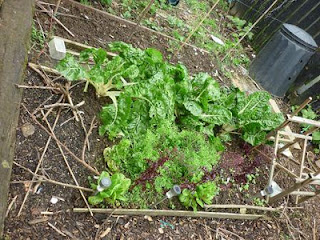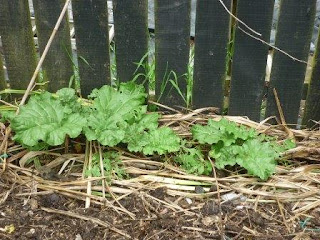Courgette "Gold Rush"
Sowing
If you havent got tomatoes, cucumbers, courgette, capsicum, eggplant, and basil planted yet its certainly not too late. However in December I wouldnt be starting tomatoes, capsicum, and eggplants from seed as they need a long growing season - buy seedlings of these if you want to give them a go for this summer. Quicker growing crops such as beans, cucumber, courgette, sweet corn, and pumpkin can still be successfully grown from seed if you start them this month.
Capsicum "Dulce Espana" with bamboo stake and pea-straw mulch
Watering
In the garden, keep your beans, courgettes, and capsicums well watered to maximise plant size, and if your capsicums are still small, unbranched plants, remove all the flowers until the plants are big enough to produce a good crop. Small plants will only produce a few small, misshapen fruit, and fruit growth is best when even night temperatures are around 20 degrees Celcius. Keep your salad greens well watered so that they dont bolt to seed or go bitter.
Dont fear the cost of using the hose! Water in Auckland costs $1.30 per 1000 litres, so the water use for any well run garden will cost only a small fraction of the value of the produce. In saying that, it is a resource so dont waste it. Generally, crops such as tomatoes and beans will grow until mid summer with the moisture they get from rain alone, and they will tell you by wilting if they need it. It is recently planted seedlings, salad greens, and courgettes that get most of my attention with the hose.
 |
| Beans "Scarlet Runner" |
Fertilising
Liquid fertilise your tomatoes, courgettes, garlic, and capsicums to grow big plants capable of producing a big crop. When these plants start to flower, switch to a fertiliser that is higher in potassium than nitrogen to encourage fruit development over more leaf growth. Most fertilisers are sold with a N:P:K ratio. Its the amount of K that is important for fruiting.
 |
| Garlic planted in June, and now growing nice fat bulbs with the help of liquid fertiliser |
Training
Tomatoes are best if they are trained up a stake or trellis, keeping one or two main branches per plant. Keeping the plants up off the ground reduces fruit rotting due to ground contact, and makes it easier to find and pick the ripe fruit. At each leaf node, tomato plants will try to grow a new branch, called a lateral. Simply nip these off when they are little with your fingers. Try to do this when they are still small and on dry sunny days - taking larger ones off when it is wet will encourage fungal diseases. Train your tomatoes tying them to their stakes at 10-20 cm intervals using a soft material. I find old stockings (panty hose) is perfect for the job as it is easy to cut, soft, and the perfect size if cut into strips across the width of the stocking.
 |
| Tomatoes being trained up the side of the garden shed with netting and strips of panty hose |
If you dont know what a lateral is, the plant on the left of the image below has laterals. These are what you should remove.
I have loved getting the children involved in the garden this month, and have needed to due to surgery that prevents me from bending over. I have been teaching my 9-year old goddaughter how to plant and train tomato plants, so she will grow up knowing a lateral from a leaf, and how to get great crops. With the way I think, I reckon growing tomatoes is a life skill alongside how to cook a meal, or how to wash a car, so its education in action in the home!
My own daughter, who has just turned 3, has been introduced to worms, and the fact that they are the gardener's friend. She will happily and gently hold them before returning them to the soil - there will be no 'worms are gross" with my kids. Annabelle also loves my "made up" stories, and has developed a liking for my worm characters - Squiggly Worm and Baby Worm. I guess they are appealing because Squiggly Worm and Baby Worm live in the garden that she can survey from her bedroom window.
As a brief synopsis of the worm saga so far, Baby Worm was hit on the head by a falling branch, and then lay injured in the garden while the stripey cat, slick starling, and copper skink all walked past without helping. They even tried to pretend that they didnt see Baby Worm by crossing over to the other side of the garden bed as they passed. It was Squiggly Worm, a lowly little creature, that was filled with compassion for Baby Worm and took him home to his worm hole to look after him. After a rest and a good feed of leaves, Baby Worm felt a lot better and returned to his home under the raspberry bushes. I am sure there is a lot of scope for teaching morals and basic truths using the imagined world of our garden.
With the arrival of the first fruits of summer, and the expenses of spring plantings mostly over, the cost-benefit analysis for November looks very encouraging (see below). Remember that this is for a garden that occupies an area 10 x 4 m, including paths, so if you only have half this area it can still make a nice difference to your monthly food bill. With the onset of drier weather I have also calculated water costs, and its good to know it isn't an issue for backyard vegetable gardens being economically viable.
Wishing you a fruit laden summer and a great Christmas and New Year,
Tim
| item | cost | quantity | value |
| alfalfa | 2.15 | 5 packs | 10.75 |
| beans | 8.98 | .25 kg | 2.245 |
| beetroot | 4.98 | .25 kg | 1.245 |
| boysenberries | 2.48 | 1/2 chip | 1.24 |
| coriander | 2.99 | 2 packets | 5.98 |
| courgette | 3.98 | .3 kg | 1.194 |
| garlic | 1.32 | 1 bulb | 1.32 |
| lemon | 3.98 | 1 kg | 3.98 |
| lime | 28.95 | 0.06 kg | 1.737 |
| mesclun | 3.5 | 6 packs | 21 |
| oregano | 2.99 | 1 pack | 2.99 |
| parsley | 2.49 | 1 bunch | 2.49 |
| radish | 2.99 | 1 bunch | 2.99 |
| rhubarb | 5.98 | .5 kg | 5.98 |
| rosemary | 2.99 | 1 pack | 2.99 |
| sage | 2.99 | 1 pack | 2.99 |
| silverbeet | 2.79 | 4 bunches | 11.16 |
| spring onion | 2.29 | 1 bunch | 2.29 |
| strawberries | 2.48 | 1 chip | 2.48 |
| 87.051 | |||
| costs | |||
| parsnip seeds | 1.99 | 1 | 1.99 |
| hose watering 100L/5 min | 1500 | $1.30/1000L | 1.95 |
| 3.94 | |||
| benefit minus costs | |||
| 83.111 | |||










